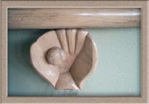FranklinArt

When making furniture, it’s worth noting that the theme of every piece has several layers of design, which, when combined in harmony, make a pleasing visual form and a meaningful whole. I would add to this approach, the consideration of the ideas of form and function. These ideas do not necessarily cooperate. They might compete. To avoid competition, the details will support the main theme. Visual movement between the details and the whole form sets up a relationship which blends the form and even the utility into one thing.
Themes may vary from reverence to humor to utility. “Function”, however, will not determine the end result though it has an important place. A spoon can be plain or it can be elaborately decorated, straight or curved, wide or narrow and could be made from many materials. The “end use” of the spoon determines some aspects of the design but does not absolutely dictate its final form.
Beauty is in the eye of the maker throughout conception and execution, but I believe the ultimate beauty will be determined by the one for whom the work is intended. The end user will decide if they like its beauty or its utility or whether the balance of the two qualities is acceptable. The balance is different for each particular user . Not often enough, but sometimes there is perfect balance.
An ideal example of furniture, despite its beauty, which is not well suited to its utility function is the magnificent throne which was very uncomfortable. The throne, fulfilled one purpose well, conveying the power and importance of the king, but remained an inadequate chair.
Enter the designer whose role is to resolve the conflicts if comfort and form.
To design means to make choices about where the emphasis is placed. Art is about this choice of emphasis, therefore the designer is critical to the outcome. Designers must choose between contradictions which are inherent in conceiving and executing ideas. Which advantage does he choose? The client may give you priorities but the conscious designer will often have to choose between contradictions. It makes for an interestingly infinite challenge. If there is an idea to aspire to I think it’s in the Latin phrase “Esse quam videri” which translates: “to be, not just to seem to be.”

furniture as vocation/avocation
The motivation driving me toward the end of every project is the exhilaration experienced while working toward completing each task, always with the hope that the results will materialize to my liking.
One often hears that there's more to it than meets the eye.
While it is true that some of the fun may meet the eye, most of it is in the experience of working out solutions to satisfy the mind as well as the eye.





